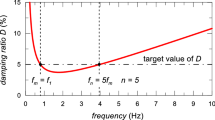Abstract
Consideration of structure-foundation-soil dynamic interaction is a basic requirement in the evaluation of the seismic safety of nuclear power facilities. An efficient and accurate dynamic interaction numerical model in the time domain has become an important topic of current research. In this study, the scaled boundary finite element method (SBFEM) is improved for use as an effective numerical approach with good application prospects. This method has several advantages, including dimensionality reduction, accuracy of the radial analytical solution, and unlike other boundary element methods, it does not require a fundamental solution. This study focuses on establishing a high performance scaled boundary finite element interaction analysis model in the time domain based on the acceleration unit-impulse response matrix, in which several new solution techniques, such as a dimensionless method to solve the interaction force, are applied to improve the numerical stability of the actual soil parameters and reduce the amount of calculation. Finally, the feasibility of the time domain methods are illustrated by the response of the nuclear power structure and the accuracy of the algorithms are dynamically verified by comparison with the refinement of a large-scale viscoelastic soil model.
Similar content being viewed by others
References
ASCE4-98 (1998), Seismic Analysis of Safety-related Nuclear Structures and Commentary.
GB 50267-1997(1997), Nuclear Power Plant Seismic Design Code.
Liao ZP (1996), Introduction to the Wave Motion for Engineering, Beijing: Science Press.
Liu Jingbo and Lu Yandong (1998), “A Direct Method for Analysis of Dynamic Soil-structure Interaction,” China Civil Engineering Journal, 31(3): 55–64.
Lou Menglin and Lin Gao (1986), “The Effect of Wave Reflection of Artificial Boundaries in Viscoelastic Media,” Journal of Hydraulic Engineering, 6:20–30.
Pang Junjie, Li Jianbo and Zhong Hong (2010), “Influence Analysis of Layered Foundation on Floor Response Spectrum of Nuclear Power Plant,” Water Resources and Power, 28(10): 67–69.
Radmanović B and Katz C (2010), “A High Performance Scaled Boundary Finite Element Method,” WCCM 2010, Sydney Australia.
Yan Junyi, JIN Feng and Zhang Chuhan (2003), “Time Domain Coupling Procedure for FE and SBFE Based on Linear System Theory,” Journal of Tsinghua University (Science and Technology), 11: 1554–1558.
Author information
Authors and Affiliations
Corresponding author
Additional information
Support by: the State Key Program of National Natural Science of China under Grant No. 51138001; Science Fund for Creative Research Groups of the National Natural Science Foundation of China under Grant No. 51121005; Open Research Fund Program of State key Laboratory of Hydro science and Engineering under Grant No. shlhse-2010-C-03
Rights and permissions
About this article
Cite this article
Li, J., Liu, J. & Lin, G. Dynamic interaction numerical models in the time domain based on the high performance scaled boundary finite element method. Earthq. Eng. Eng. Vib. 12, 541–546 (2013). https://doi.org/10.1007/s11803-013-0195-8
Received:
Accepted:
Published:
Issue Date:
DOI: https://doi.org/10.1007/s11803-013-0195-8




